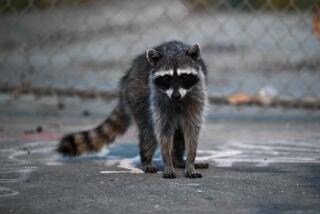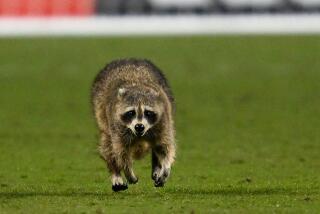Making Out Like Bandits
- Share via
Excluding Rocky, the gun-toting hero of the old Beatles song, Bandit may have been the biggest name in the raccoon world. Tipping the scales at 72 pounds, three times normal size, this Orson Welles of the animal kingdom made the Guinness record book as the porkiest raccoon of all time.
A regular at Ice Cream World in Walnutport, Pa., Bandit could often be found outside drinking a blueberry slush through a straw. “He was my best friend,” said former owner Pepper Klitsch, 48. She still hasn’t gotten over his death earlier this year.
As attacks on humans by cougars and coyotes become regular fare on the evening news, it is apparent that problems with urban wildlife are increasing. Of all the large animal invaders, however, it is the raccoon that is colonizing human habitat as well as any. Whip-smart, nearly as skillful with his hands as a safecracker, and curious to the point of walking right into your house, the raccoon is surviving and thriving where others struggle. Some, like Bandit, move in and take control of the remote.
Bandit especially loved watching animal shows on TV, Klitsch said. Unless the show was about sea creatures. “Then he’d change the channel.”
Raccoon attacks on people are rare. And though many people are so fond of them that they set out food, some experts say things have gotten too cozy between humans and raccoons. Most scientists agree that there are more raccoons in America today than when the Europeans first set sail for the New World. More raccoons roam within a mile of his urban campus office “than in 10 square miles of Yosemite,” said San Jose State biology professor Bill Murray.
Some raccoons become so dependent on French fries and doughnuts that it undermines their ability to survive in the wild. They also make life miserable for homeowners. Pregnant raccoons cause thousands of dollars in damage breaking into attics seeking a safe place to give birth. They consider the backyard water gardens so popular in Southern California to be their personal sushi bars, eating expensive koi as fast as homeowners can replace them.
So many urban raccoons carry a potentially fatal type of roundworm that the U.S. Centers for Disease Control and Prevention lists it as an “emerging infectious disease” posing an increasing threat to human health. Scientists like Murray say it’s time people stopped thinking of raccoons as cute masked fur balls and started thinking of them as pests.
“This is an animal that is causing a lot of destruction,” said Murray. “But very few people have a clear idea what wildlife is anymore. We’ve lost the ability to make pragmatic decisions” about how to control them.
“Raccoon” is said to come from an Algonquin word, arakum, which means “He scratches with his hands.” Raccoons’ ability to manipulate their environment with their hands is one reason humans have tended to anthropomorphize them. Almost two-thirds of the raccoon’s somatic sensory cortex is devoted to computing and evaluating information gathered by millions of receptors on the animal’s fingers.
Essentially, the raccoon “sees” the world with his hands. That’s why they can manage amazing feats of dexterity, such as reaching deep into a log for grubs or breaking into basements and chicken coops despite the best efforts of humans to keep them out.
Jill Giel, who rehabilitates injured raccoons at the Folsom City Zoo Sanctuary outside Sacramento, said her animals figured out how to use the lock on their cage to keep her out. They stopped when they realized “if they locked me out, their dinner was late.”
That superior tactile sense, rather than fastidiousness, explains the other behavior humans find so endearing. “They don’t wash their food,” said Erik Fritzell, associate dean of Oregon State University in Corvallis. “They put the food in water to enhance the feeling.”
That would explain Berkeley freelance writer Joe Eaton’s surprise when he found a raccoon dunking his turtle Studs in the turtle’s water dish “like a doughnut in coffee. Studs appeared surprised as well, not to say traumatized,” Eaton wrote in Faultline, a Bay Area environmental magazine. Studs, a three-toed box turtle that has belonged to Eaton for 25 years, survived the ordeal.
Though more numerous in the East and Midwest, raccoons are found in 42 of California’s 48 habitat types, said Tom Blankinship of the state’s Department of Fish and Game. In the wild, a raccoon’s life can be nasty, brutish and short, rarely reaching 10 years. Besides predation, a major cause of raccoon mortality is canine distemper, which can decimate entire populations. With human help, they can do much better. Giel said some of her sanctuary animals have lived well into their teens.
Several factors explain the raccoon’s success story. Foremost is their flexibility. “Raccoons are supremely adaptable,” said Murray. They can live most anywhere. A hollow log is great. A tree branch will do. A hole under the porch works fine. Even in a frosty big city, Toronto, researchers counted 160 raccoons per square mile. Females have large litters, sometimes as many as eight young. They eat virtually anything, including garbage. In agricultural areas, they can chew up whole stands of sweet corn. In Illinois, they are thought to be behind a decline in low-nesting songbirds.
The diet of city raccoons more closely resembles that of a teenager. Stan Gehrt, assistant professor of wildlife ecology at Ohio State University, said “French fries really get them stirred up. They fight over them. The other thing they like is Dunkin’ Donuts.”
Bandit was even more of an epicure, favoring such things as chips, cheese and Froot Loops. When Klitsch decided he needed to go on a diet, she locked up Bandit’s favorite peanut butter snacks behind a sliding bolt. Undeterred, he figured out how to lift the handle and slide the bolt to get at the treats.
Raccoons also display an ability to work together. Gehrt observed male raccoons forming partnerships, something rare among many mammalian species. Fritzell, of Oregon State, recalled the woman who called for help to get rid of a horde of ravenous raccoons on her porch. She started feeding one, but by the time she called there were 27. She was going through 50 pounds of dog food a week.
Another factor in the success of raccoons, researchers say, is the decline of hunting and trapping. As late as the 1970s, 3,000 fur trappers were licensed in California, said Blankinship of Fish and Game. That number is now down to about 200 as the demand for raccoon caps and coats plunged. Pelt prices now hover at $8, hardly enough to make it worth the effort to catch the animals.
Another reason raccoons have succeeded in cities is the growth of the animal rights movement. In 1998, after an infant was stricken by a raccoon roundworm infection that left him brain-damaged, authorities in the Monterey Bay community of Pacific Grove decided to cull the raccoons, which were so numerous that motorists had to steer around them. The decision stirred outrage, and activists held candlelight vigils. The city no longer traps or euthanizes raccoons.
Murray, a specialist in parasitic diseases who consulted on the case, received threatening calls at home. Two people posing as FBI agents tried to arrest him. “I went to my office to call the regular police and they ran off,” Murray said.
On the other side, passions were just as heated. People stopped the boy’s father, Sam Read, in the street to boast of killing raccoons. “I got two the other day,” Read recalled being told. “I was thinking of you.”
The roundworm, Baylisascaris procyonis, is a growing threat to raccoon neighbors. It lives in the raccoon’s small intestine, and, like most parasites, does little damage to its host. “All species except raccoons suffer horribly from this disease,” said Murray. Human victims, mostly children, appear lethargic or irritable at first, making the illness hard to distinguish from other childhood diseases. Without treatment with a worming medication, victims can lose their sight, suffer brain damage or die.
The disease is transmitted through the worm’s eggs, millions of which are produced each day and shed in the feces. Once outside the body, the eggs can survive for years.
“Most people think, what person would eat feces?” Murray said. But it’s not uncommon for young children to put things in their mouths. The eggs can also survive in dirt after the fecal matter has blown away. Walter Boyce, of the UC Davis Wildlife Health Center, said a child in Indiana was infected by chewing on firewood.
Two cases have been reported in California in the last four years, one in Los Angeles and the other in Santa Barbara. “It’s a rare infection, but there’s going to be more,” said Murray. He also believes neurological problems seen in zoo animals are being caused by the roundworm.
Meanwhile, urban life just seems to get better for raccoons. They must be delighted by how many Southern Californians are installing backyard water gardens and stocking them with fish, said local wildlife experts.
“A neighborhood rich in koi, trash and dog food can have lots of raccoons,” said Troy Boswell, an animal control officer for the Los Angeles Department of Animal Services.
Any discussion of raccoons eventually comes around to their intelligence. Just how smart are they? Those who study them often find themselves admiring their resourcefulness, as well as their curiosity. More than one family has noticed raccoons watching them going about their daily routines.
Gehrt said raccoons are deceptive because they all look about the same. “Some have a bad attitude about life. Others are mild-mannered.”
Their combination of cute and clever has led some people to try to breed raccoons as pets. Some, like Bandit, take to a life of slushes and sleep. Raised around dogs, he even tried to bark like them, Klitsch said.
Most, however, turn wild at about age 2, snarling and baring their teeth.
The raccoon’s intelligence can also make it an especially tough opponent for the homeowner who, fed up with seeing his lawn dug up and fish stolen, decides to declare war. Internet chat groups on raccoon problems are replete with expressions of desperation, admiration and befuddlement. “These critters are really bold,” writes one. “Last week, two huge raccoons decided to duke it out on our back patio,” says another. “I swear ... the raccoons are getting stronger and smarter,” adds a poster named Catherine. “I’m about to just give up.”
Pest control experts suggest trying to repel the creatures with cayenne pepper, wolf urine (where do I get that? one homeowner wondered), mothballs (one man got blood poisoning from filling up his chimney with them), and electric wire. One solution that worked for several raccoon warriors: putting out a radio tuned to an all-talk station. But nothing seems foolproof.
Eaton, the Berkeley writer, recalled a science fiction novel about a parallel earth dominated by raccoons. “Made perfect sense to me,” he noted in his Faultline article.
More to Read
Sign up for Essential California
The most important California stories and recommendations in your inbox every morning.
You may occasionally receive promotional content from the Los Angeles Times.













